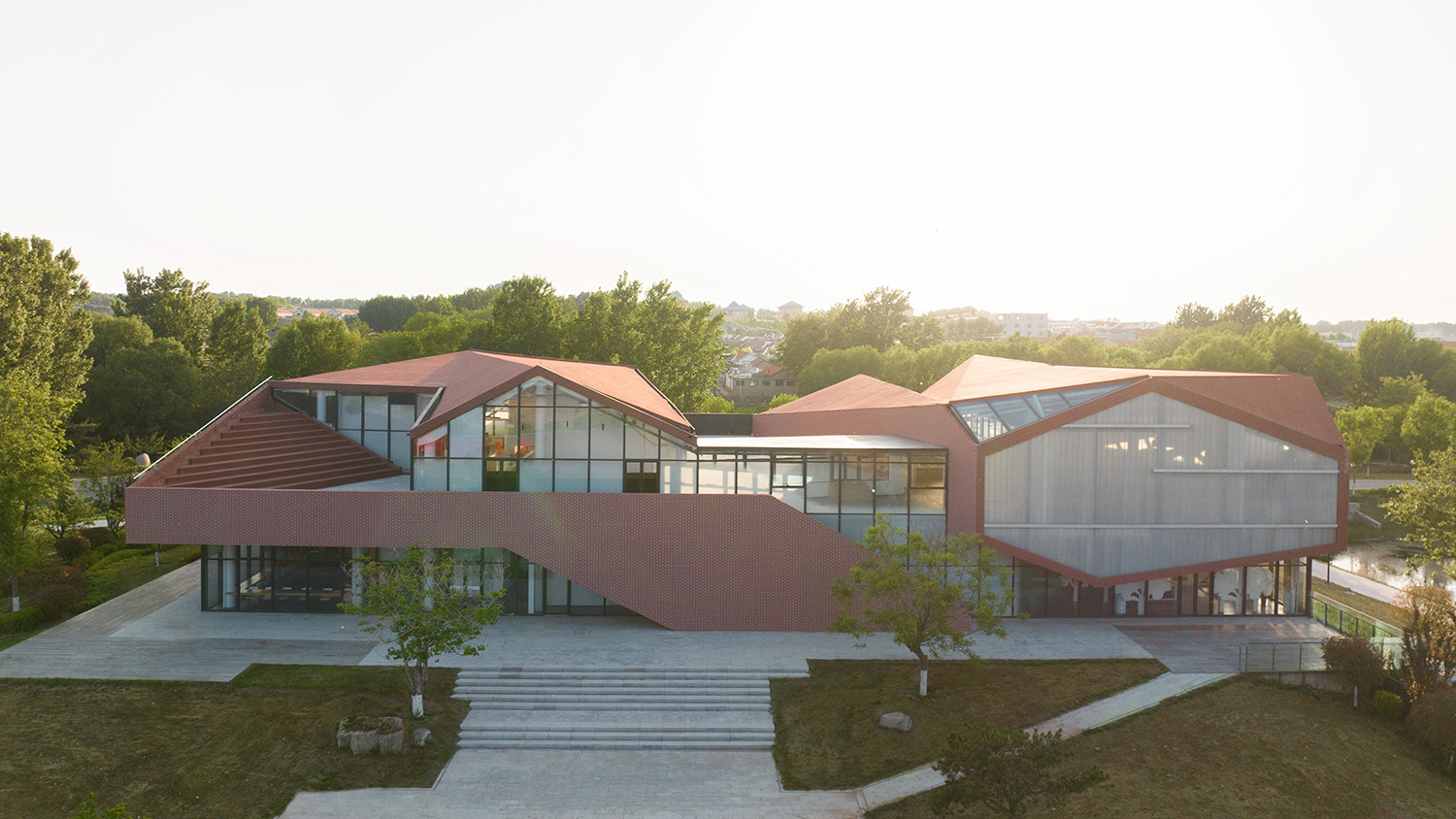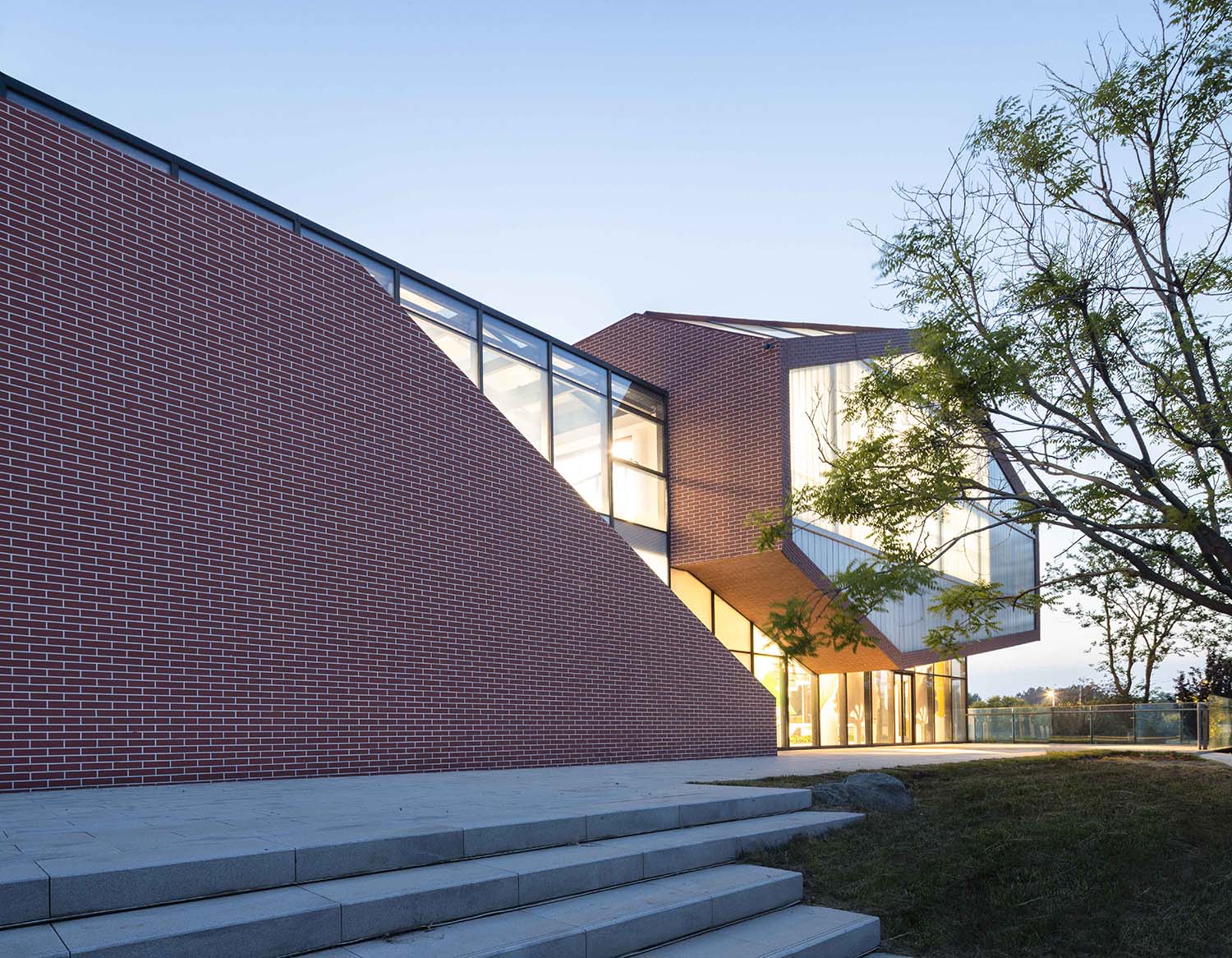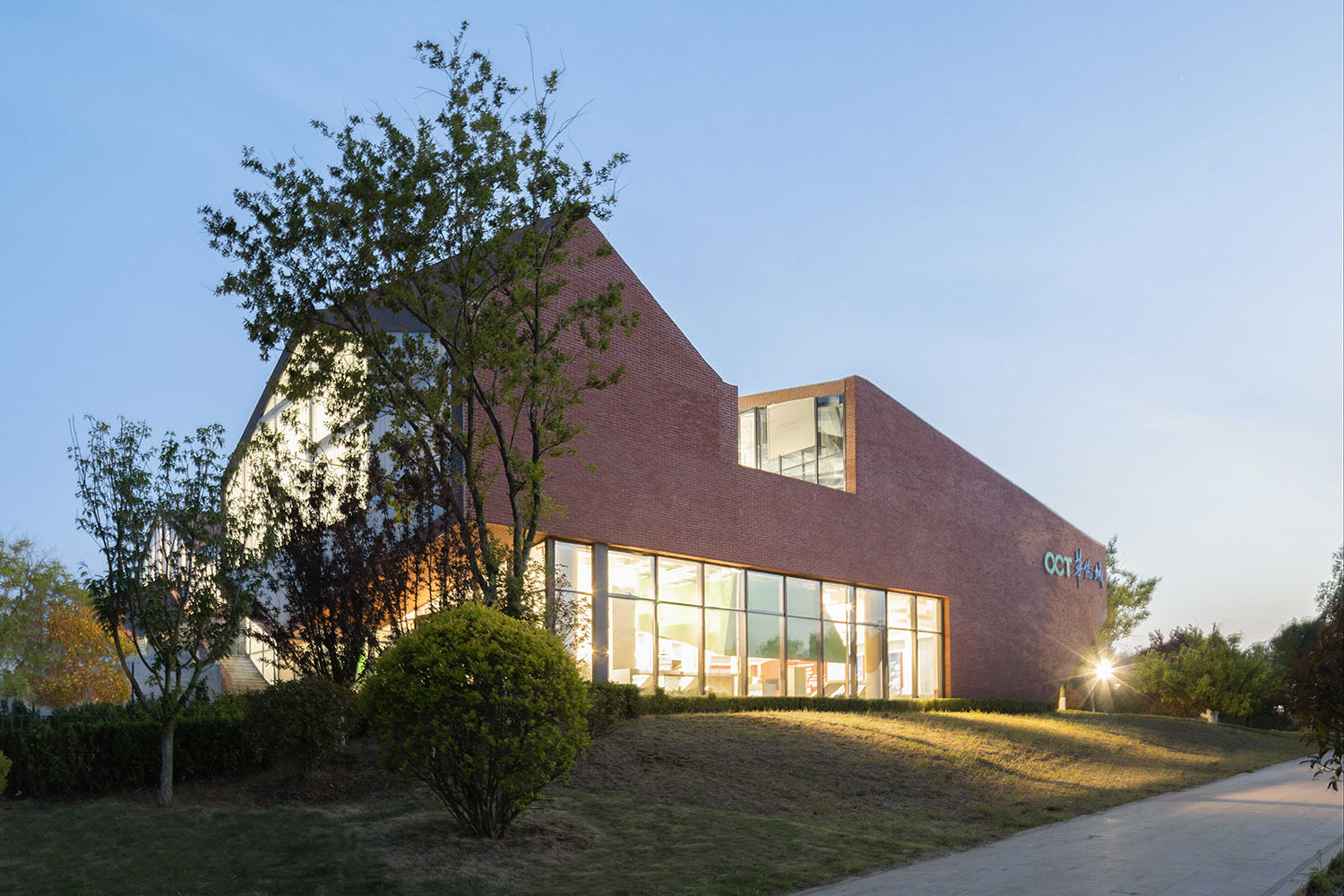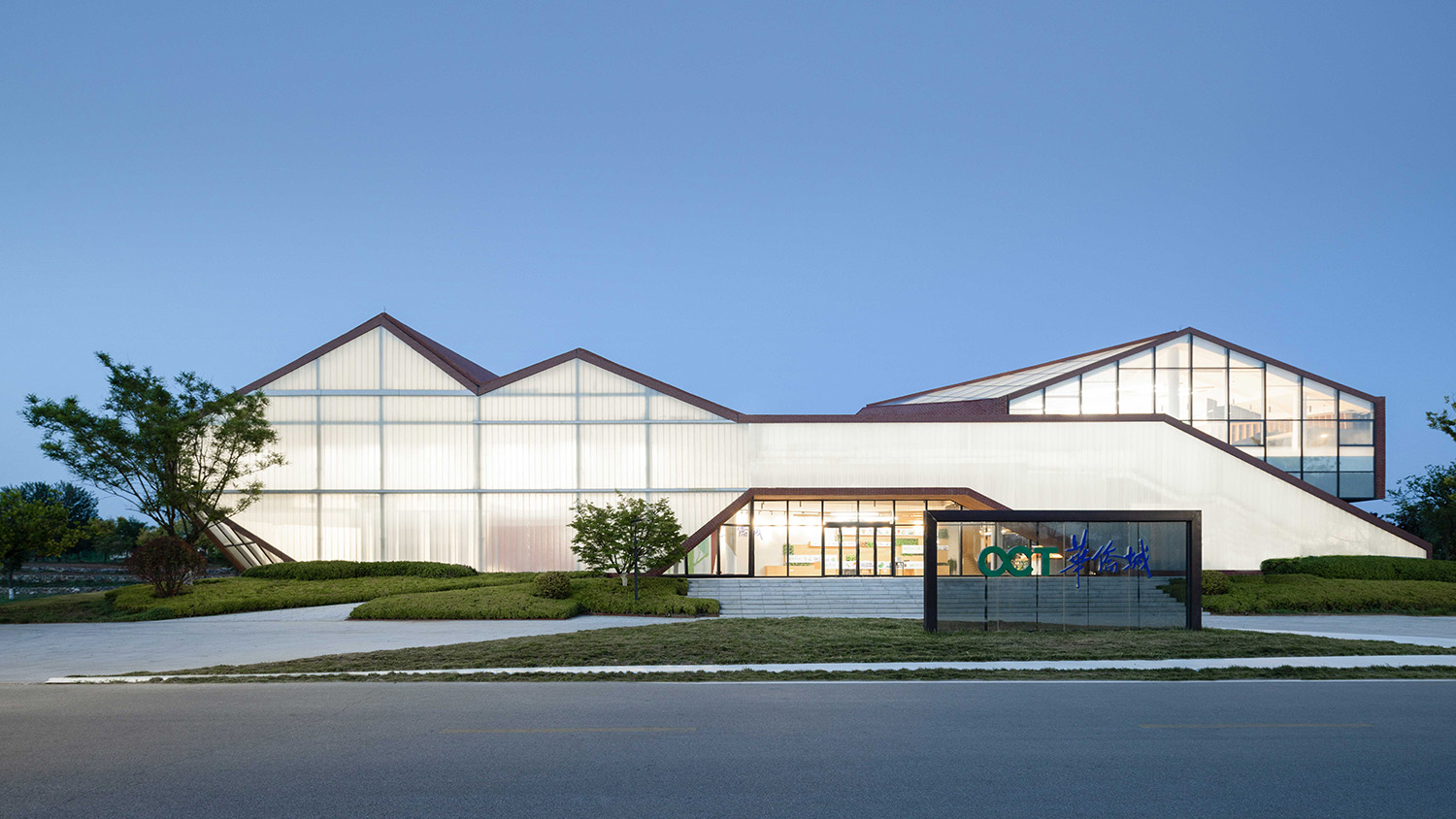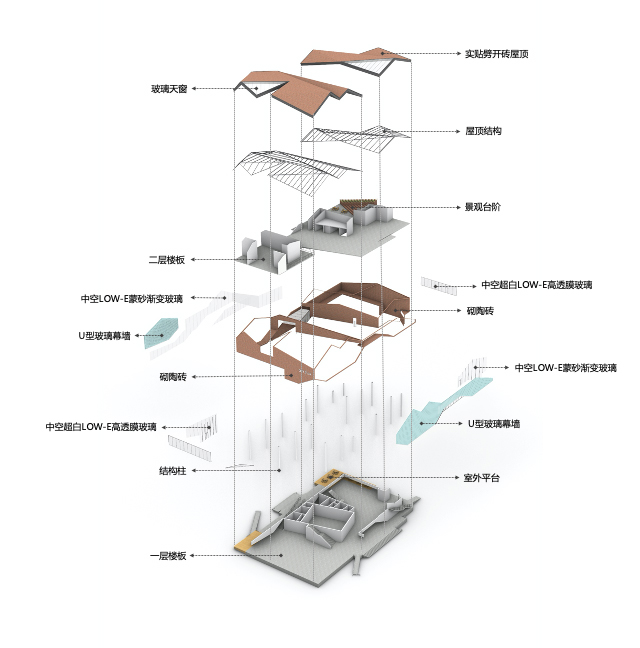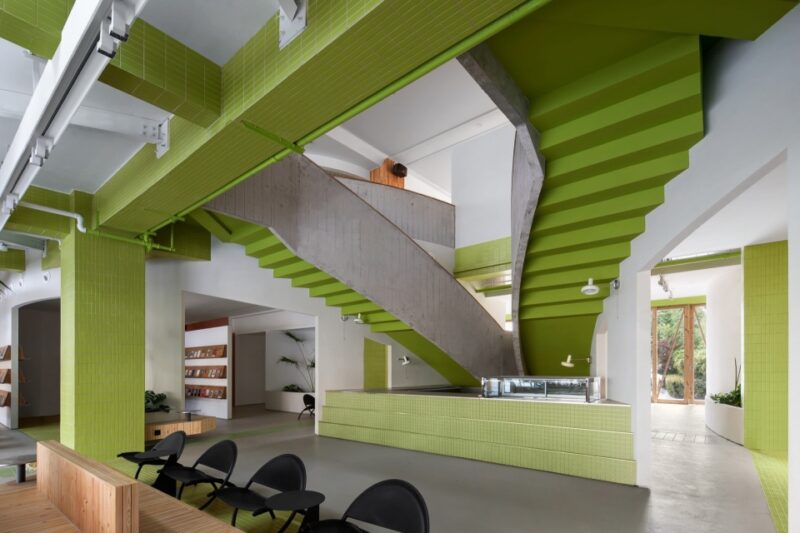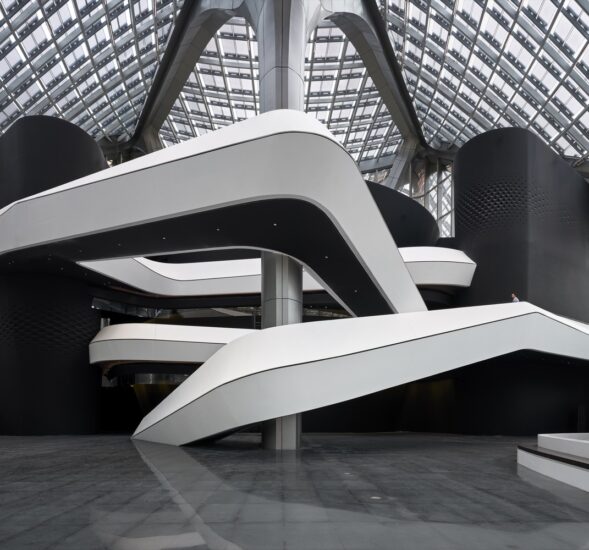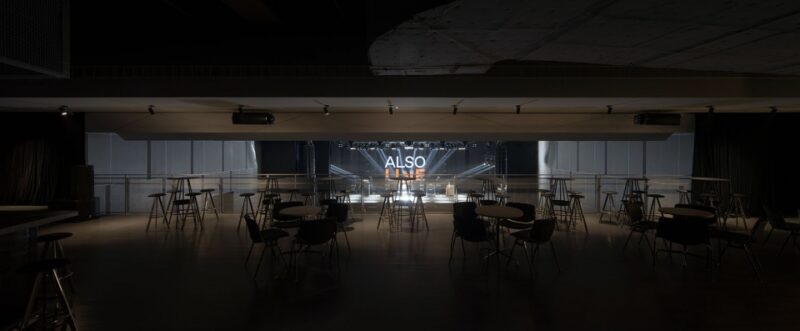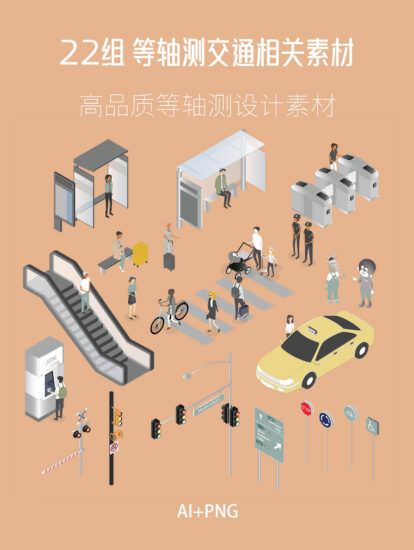雕琢鄉村璞玉,靜待塵盡光生
Carved Forms in Countryside Terrain
鄉村,是一塊未經雕琢的“璞玉”——它的美麗尚未成形,它的價值不可估量。鄒迎晞帶領的袈藍建築始終將一片熱忱投注於鄉村的沃土,精心打磨,助璞石成玉。
China’s countryside terrain can be seen as an uncut “unpolished jade” – its beauty is in many ways undiscovered, and its potential value is immense. Led by architect Zou Yingxi, the Jimo OCT Rural Revitalization Culture Center project embraces the fertile soil of the rural landscape and carefully polishes the metaphorical stone within, transforming it into something new and precious.
鄒迎晞將袈藍建築定位為“助產士”,並不直接給出鄉村發展、城鄉融合的確定性答案,而是予之以生長性的留白,喚醒建設者和使用者對未來的期待、對曆史的情愫、對生態的責任。
Zou Yingxi has positioned SYN Architects as a kind of “mediator” between urban and rural integration – rather than seeking fixed responses to the development of the countryside, he prefers to create open-ended solutions which can invigorate both builders’ and users’ expectations for the future. This approach also encompasses a thorough understanding of culture and history, as well as an attentiveness to the nature of each project’s environment.
2020年,華僑城青島即墨蓮花山鄉村振興示範區項目展示中心(以下簡稱華僑城鄉村振興展示中心),袈藍建築首次將“未完成的璞玉”這一富有精神意涵的媒介轉譯為具象的空間。
In 2020, the Jimo OCT Rural Revitalization Culture Centre and SYN Architects began the process of translating the spirit of “unpolished jade” into a fully realized space.
01.規劃、建築、運營,共構生活場景
Planning, Construction, and Operation: Collectively Creating New Vistas
在袈藍的DNA中,城鄉融合的願景絕非依靠單一空間就能實現,他們始終通盤考慮規劃、建築、運營的全局,深挖場域之內的既有社會關係、空間邏輯、產業布局、文化曆史、自然生態。基於文旅發展的總方向,以國際藝術節為驅動,為青島即墨龍泉-蓮花山城鄉融合示範區引入新空間,創造新場景,構建新產業。
In the view of SYN Architects, the ideal conception of urban-rural integration cannot be realized through the design of a single space. They consider each project to be a microcosm of a bigger picture, and always take into account the overall system of planning, construction, and operation to deeply investigate existing social relations, spatial logic, industrial factors, cultural history, and the natural environment. For the Jimo OCT building, an approach based on general trends of cultural tourism and the area’s International Art Festival was developed. It introduces new spaces and settings with the potential to complement other economic activity in the Jimo Urban-Rural Integration Demonstration Zone.
∇ 項目區位圖
這片距主城區70公裏的沃野,與青島火車站、機場相距不遠,緊鄰龍青高速,一手城市、一手鄉村,臨山近水,致力於為久居城市的人們提供一個具備城市配套、樂享便利生活、慢品人生的“後花園”。
The site started out as an agricultural field, 70 kilometers away from the city centre, not far from Qingdao Railway Station and the airport. It thus presented an advantageous location, mediating between urban convenience and countryside leisure.
“很多所謂‘鄉村設計’不考慮資本、運營和生活,非但沒有解決鄉村問題,反倒造成大量沉睡的資產。很多所謂的‘建築複興’生硬地回應所在地的文化,反倒忽略了對未來生活與審美的思考。”
——鄒迎晞 袈藍建築創始人兼主持建築師
“In my experience, many ‘rural designs’ do not consider economics, operating logistics, and everyday management. Rather than solving problems in the countryside environment, they create projects which leave the assets of their sites largely dormant. The majority of projects which aim to revive vernacular architectural styles in fact respond bluntly to local cultures, while ignoring any potential for future advancements in life and aesthetics.”
——Zou Yingxi, Founder of SYN Architects
於是,在項目的規劃圖景中,山地運動、自行車驛站、康養度假、三產融合……均被袈藍反複推敲,空間與藝術成為綜合運營的抓手、刺激點、引流手段,用一連串完整的、相互補充的連貫場景,予以“璞玉”生活的溫潤。
With a more complete approach in mind, SYN Architects began the planning stages of the project by integrating facilities for mountain sports, bicycle stations, health resort and local businesses, among others. Spatial and aesthetic considerations were the starting point, used to create a series of stimulating architectural settings which complement each other and socially activate the site, bringing the site’s “unpolished jade” to life.
02.形式,“雕一半的璞玉”
The Form: “Rough Jade, Half-Carved”
∇ 屋頂切割
作為整體片區的先行示範單元,華僑城鄉村展示中心裝載著一連串以發展為名的“願景”,是綜合發展的激活點,它的周邊是一連串青島典型的紅屋頂建築,新建築內裏裝載著產業布局、空間布局、展示銷售的職能,亦以咖啡、輕食餐廳等業態擁抱未來的生活。
As a leading landmark building in the area, the Jimo OCT Rural Revitalization Culture Centre is seen as a prime example for how future development could take form, while acting as a first point of development to activate the local economy. Surrounded by a series of red-roofed buildings typical to Qingdao, the new building contains spaces for local businesses to display and sell their goods, while also embracing contemporary culture with coffee shops, light food restaurants, and other small businesses.
它有限度地從周遭選擇需要回應的符號——紅磚、U型玻璃幕牆和高透膜玻璃模仿石與玉的顏色及質感,與當地紅瓦白牆的建築風格遙相呼應。屋頂與牆麵采用相同材料,實現上下包裹的一致性,讓“玉”更純粹。
The project selectively responds to important architectural cues in the surroundings – red bricks, U-shaped glass curtain walls, and high-permeability glass imitate the color and texture of stone and jade, while echoing the local architectural vernacular of red tiles and white walls. The same materials are used for the roof and the wall to achieve a consistency in the upper and lower cladding, making the resulting “jade” purer.
∇ 形體演變
它的“切割”尊重場地,尊重景觀,由此勾勒出不同的觀景視窗,內凹體量生成一連串灰空間,配合屋頂開口處的露台,形成室內與室外、景觀與建築豐富的交互。“切割”而成的傾斜屋麵不僅是對場地周邊建築文化的回應,屋麵立麵接縫處的天溝實現了雨水的收集,文化與功能合為一體。
“Cutting” the jade has been done in a way that respects the site and landscape, framing certain selected views and scenes. The concave volume creates a series of variegated spaces, and merges with the terrace at the roof opening to form a rich interaction between indoor and outdoor, landscape and architecture. The “cut” sloping roof is not simply a response to the architectural forms surrounding the site: the gutters at the joints of the roof facilitate the collection of rainwater, integrating culture, aesthetics, and function.
而在建築之外,袈藍亦將運營邏輯納入考慮,在設計中預留舉辦藝術活動的可能性,以田園基底承載藝術元素。這線設計延續了建築“切割”的設計手法,串聯了花田、棒棒糖景觀、觀景台、水景、無動力樂園等休閑場景,打造科普菜田、觀光花田、藝術地標等網紅勝地,並構築人與自然的多維度互動,在變幻的風景裏,輾轉抵達建築。
In addition to the building design, SYN architects also took daily operating logistics into consideration, planning the space to comfortably hold live art-related events and workshops, merging culture with the countryside environment. This was achieved through the implementation of an architectural “cutting” method, carving into the building’s form in order to create observation decks and water features which visually and spatially connect to various settings such as fields of wildflowers, distant landscapes, and untouched forests. This creates multiple perspectives and photographic opportunities for visitors keen on posting on social media, with this abundance of rural scenes visible from a new artistic landmark – thus establishing a multi-faceted interaction between people and nature, and creating a base from which the changing landscape can be seen afresh.
∇ 建築景觀一體化設計
而精心設計的景觀,亦成為立身建築內的觀賞對象,一幅遊園、觀景、賞藝的生動圖景由此生成。建築成為移動之中的觀賞對象,它的切割形體不斷“抵達景觀”,每一麵均呈現不同的樣貌。看與被看之間,藝術、建築、自然融為一體,功能性、藝術性、思想性交織融合。
The thoughtful logic of the mediated landscape becomes the object of appreciation of the building, and drives the design which encompasses vivid views of a variety of both cultivated and wild scenery. The building becomes an object for observation, out towards the environment, and in toward art and architecture. Its sculpted shapes reach out to the landscape, each side presenting a different, variegated appearance. Bridging between seeing and being seen, art, architecture, and nature are brought together, integrating function, aesthetics, reflecting, and feeling.
用折線而非曲線,似是有悖於“玉”的圓潤。但袈藍希望營造一種“中間態”,建築是一枚“未完形的玉”,雕琢、打磨的“銼刀”理應交給建設者和使用者。
At first glance, the employment of angular lines rather than gentle curves seems to run contrary to the roundness of conceptual jade. But SYN architects hopes to create a kind of “intermediate state”, where the building is seen as “unfinished jade”, and the “file” for carving and polishing it in the end is given to the builders and visitors.
03.空間,不斷生長的生活
The Space: Constant Growth
∇ 建築分解圖
在室內的平麵構成中,“切割”的語言再次得到延續。室內功能與室外功能的互動關係是功能排布的重要依托,視覺的互動、場景的關聯,共同模糊邊界,拓展了體驗的連貫性。
The language of “cutting” on the exterior is also employed for the interior spaces. The interactive relationship between indoor and outdoor functions is an important basis for space planning, with visual interaction and the connection of various scenes blurring boundaries and creating a seamless continuity of experience.
∇ 建築流線分析
展覽展示空間、有溫度的服務空間兩種功能相互融合,滿足展示中心作為舉辦各類文化藝術展、商業性展覽及藝術活動的交流場所的需要,回應兩種功能並存的訴求——既是鄉村振興成果展示的重要場所,也是田園文化與時尚生活的展現舞台。
The two functions of exhibition space and accompanying service space are integrated in order to meet the needs of the Centre as a place for holding various art exhibitions, cultural activities, and commercial events. The design of the building is an important place to display the achievements of rural revitalization, but also a stage for the celebration of the history of rural culture and contemporary life.
蜿蜒起伏的條形長桌成為“切割”空間的媒介,它將商品售賣台、水吧台及休息桌全部連接起來,不僅限定出空間區域,同時也能夠滿足使用功能。長桌的設計還對應出現在展示區中,引導流線、布置展陳及增加空間趣味性。在體現整個空間內部關聯的同時,仿佛一條紐帶融合了白色與木色構成的城市與鄉村。
The main space’s winding long table becomes the medium for “cutting” the interior. It connects the merchandise counter, the water bar and the rest area bench, providing spatial definition while satisfying functional necessities. The design of the long table also extends into the exhibition area, guiding circulation, aligning the art on display, and providing a defining visual element in the space. When stepping back and seeing the entire interior space, it seems to act as a link composed of pure white and wood that joins the city and the countryside.
透過折疊的空間,步入被建築師精心打造的場景,每一步行進都有情感的起落,生成對空間、文化、生活不同維度的理解。
As they enter this folded space, visitors step into a series of carefully modulates scenes created by the architect, with each step generating varying emotions and changing dimensions of space, culture and thought.
04.未琢之玉用心雕琢,鄉村圖景臻於至善
Carving Jade, Perfecting the Countryside
在青島即墨這座擁有者1400多年曆史文化的古城中,風光旖旎的蓮花山片區少有人問津,仿佛一塊蒙塵的“未琢之玉”。鄒迎晞以玉石家的狀態審視、雕琢這片場地,讓璞玉光芒漸現,緩緩鋪設一段不斷發展的空間和感官之旅。他希望這段旅程不僅向社會各界展示出華僑城青島即墨蓮花山鄉村振興示範區項目“臻於至善”的美好願景,也以集功能性、藝術性、思想性為一體的國際田園勝地之姿,為城鄉融合美好畫卷的繪就增添絢麗色彩。
In Qingdao Jimo, an ancient city with a history and culture of over 1,400 years, the beautiful surrounding countryside is rarely visited, like a forgotten piece of “uncut jade”. Zou Yingxi examines and carves this site, allowing the light of raw jade to gradually emerge, and gently lays down a constantly developing spatial and sensory journey for new visitors. He hopes that this journey will not only reveal the enlightened vision of the OCT Qingdao Jimo Rural Revitalization Project to “Pursue Perfection” in all walks of life, but also add innovative elements to the emerging scene of urban-rural integration with the emergence of an International-quality Rural Centre integrating the highest levels of functionality, artistry and thought.
∇ 總平麵圖
∇ 一層平麵圖
∇ 二層平麵圖
∇ 立麵圖
項目信息
項目名稱:華僑城青島即墨蓮花山鄉村振興示範區項目展示中心
主持建築師:鄒迎晞
建築設計團隊:陳士方,雷中華
室內設計團隊:夏福強,錢國興,曹真真,劉婷婷,李倩茜,馮炎,郭萌佳,李輝
占地麵積:60000㎡
建築麵積:2200㎡
設計時間:2020年5月-7月
完成時間:2021年
項目地點:山東/青島即墨
業主:青島華僑城投資有限公司
攝影師:直譯建築攝影
Project Name: Jimo OCT Rural Revitalization Culture Centre
Lead Architect: Zou Yingxi
Architectural Design Team: Chen Shifang, Lei Zhonghua
Interior design team: Xia Fuqiang, Qian Guoxing, Cao Zhenzhen, Liu Tingting, Li Qianqian, Feng Yan, Guo Mengjia, Li Hui
Area: 60000㎡
Construction area: 2200㎡
Design time: May-July 2020
Completion date: 2021
Project location: Shandong/Qingdao Jimo
Owner: Qingdao Overseas Chinese Town Investment Co., Ltd
Photographer: ArchiTranslator










